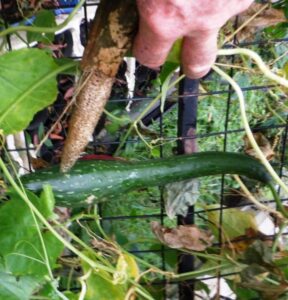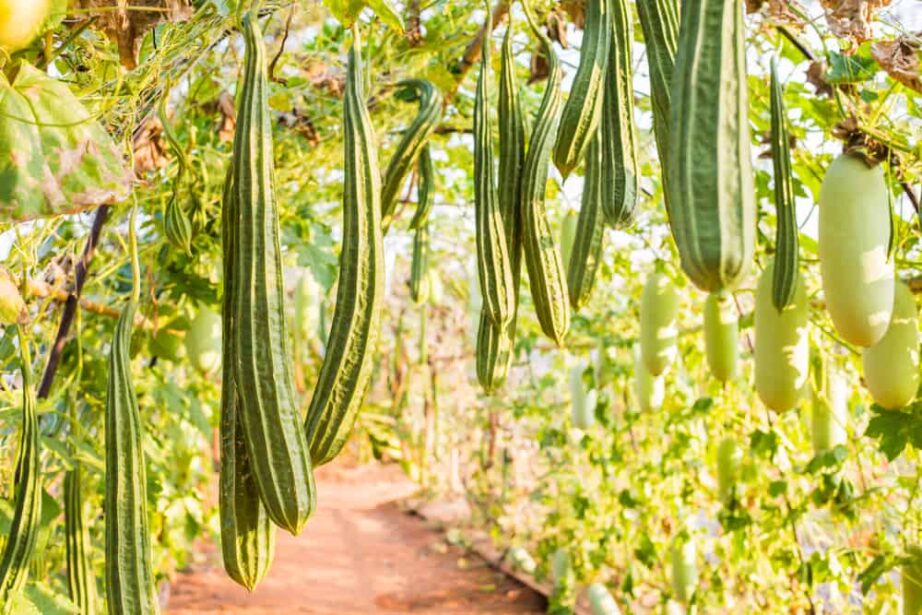You know those loofah sponges you can buy at fancy stores? Those aren’t some strange sea creatures. They’re actually the fibrous flesh of the luffa gourd.

Luffa gourds aren’t just useful for making bath and kitchen sponges, though. You can also eat them. What’s better than a multi-purpose garden plant?
Interested in growing luffa? We’re glad because these plants are awesome. Here’s what to know:
All About Luffas

Luffa is a plant used for making luffa or loofah sponges, and while it isn’t hugely popular in home gardens yet, it’s perfect for growing at home. Luffa is native to Southeast Asia, but you can grow this plant in USDA Hardiness Zones 7-13 or Zone 6 if you start it indoors in the spring.
The two main species of luffa gourds are angled (Luffa acutangula) and smooth (L. aegyptiaca). L. acutangula has ridged and firm skin, while L. aegyptiaca is smooth. Both have the same flesh. Smooth is the most common variety to grow at home.

There are several cultivars of smooth luffas available on the market, including ‘Smooth Boy,’ ‘Smooth Beauty,’ and ‘South Winner.’ Angled luffa cultivars include ‘Lucky Boy,’ ‘Hybrid Green Glory,’ ‘Summer Long,’ and ‘Hybrid Asian Pride.’
Luffa grows rapidly and tall, up to 23 feet. The blossoms and fruits have a vibrant yellow color. It’s typical to find lots of bees and butterflies around the colorful flowers, so you can attract more wildlife by growing these in your backyard.

Planting Luffa From Seed

The first step in growing luffa is, obviously, to find some seeds. You can check your local gardening center or order them online at places like Amazon if they are difficult to find nearby.

Alternatively, you can keep seeds from previous plants and plant new luffa gourds. If you have a friend growing luffa, see if they’ll share some seeds. Store them in a cool, dry place until you’re ready to use them.

You can rarely find seedlings at specialty nurseries, particularly if you live somewhere warm like Florida or Hawaii, but they’re rare in most other areas.
The best time to plant luffa gourds is a few weeks before your area’s last predicted frost date. Plant them indoors in pots filled with a loose, water-retentive potting soil like FoxFarm’s Ocean Forest potting mix. Place the seeds roughly one fingertip into the soil and water the soil so it’s moist but not soggy.
Place the pots under grow lights for eight hours daily or in a sunny window where they will receive eight hours of direct light. Keep the seeds moist as they germinate. You should see the germination in 20 days.

Once the seedlings have at least four true leaves and the last frost date has passed, you can put them in the ground outside after hardening the seedlings off.
If you have a long growing season, you can start the seeds directly outdoors in prepared soil. Plant a few weeks after the last predicted frost date. Plants should be placed at least five feet apart.
Caring for Luffa Gourds

Having enough sun is an essential part of growing luffa gourds. You must give this plant at least six hours of sunlight daily, but eight or more is better.
The correct temperature is also crucial for growing luffa gourds—plant when the low temperatures of the day are higher than 50°F.

You won’t see healthy fruits developing on your plant without the correct soil. You need fertile soil that is well-draining. A pH level of 6.0-6.5 is ideal. You might need to work in lots of well-rotted compost to make your soil loose and well-draining.
Fertilizing and Pruning

Nitrogen is vital in growing luffa gourds, and with most vegetables, as it supports healthy growth.
You should monitor your plants’ growing process; if you notice they are developing slowly, use a slow-release nitrogen fertilizer. Always check the label and reviews before using a new product.
Choose a product labeled as vegetable fertilizer, like Big A## Tomatoes, which is an excellent choice because it’s packed with goodies like kelp, which veggies love.
In addition to growing these on a trellis or fence, you’ll want to prune off any growth that hangs too low or tries to crawl somewhere that you don’t want it. If you want to encourage larger fruits, harvest off some of the young gourds as they first form.
Luffa Gourds Pests and Diseases

Leaf miners and cucumber beetles are common pests of luffa gourds.
Cucumber beetles love to snack on luffa leaves and stems, and the young feed on the roots. The pests will also spread to other nearby plants in the Cucurbitaceae family, so your pumpkins, cucumbers, and zucchini are at risk, too.
The most common symptoms of cucumber beetles are discolored or holey leaves, and slow growth. These pests can completely defoliate a stem if left unchecked.
Make sure to visit our guide to learn how to address them.
Leaf miners are tiny larvae that chew holes through the leaves of many different species of plants. If you see what look like weird mazes in your leaves, it’s probably leaf miners. The feeding doesn’t usually harm your plant too much, but they spread diseases that can cause serious issues.
We have an article that explains how to deal with these pests.

Powdery mildew is a common disease that affects many plants in the garden. It particularly loves cucurbits. This disease causes a white powder that coats the leaves, reducing photosynthesis and gradually causing the leaves to turn yellow and wilt.
There’s also a chance that powdery mildew can spread if you don’t get rid of it. Our guide can help you deal with powdery mildew.
Harvesting Luffa Gourds

You can either harvest luffa gourds for eating or making into sponges. If you want to harvest young luffa gourds for eating, you should wait until the fruit is green and looks similar in color and size to a cucumber.

A refrigerator is a good place for keeping your harvested luffa gourds, but you should eat them as soon as possible if you want the best flavor.

If you’re more interested in the sponge interior, you need to let the fruits ripen on the vine before harvesting. You’ll know that luffa gourds are ready to pick when they turn to a tan color and become lighter. The outer skin will also be hard, so try pressing a fingernail into the skin to see how it feels.

Cut off the fruit a few inches from the stem.
After you’ve picked the fruit, you need to store it somewhere protected from humidity.
Making Luffa Sponges

The skin will turn brown when your fruits are ready to be harvested for sponges. Once you take them off the vine, take off the outer shell. If the skin comes off easily, you’ll know it’s completely ripe.

Leave the fruit in water if the skin is hard to remove, as it will soften the shell and make it easier to peel off several gourds.

Then, rinse the sponge and leave it to air dry. If you want to make them easy to hang, you can pierce a hole in the top and bottom and place a string through the gourds. This makes it easier to hang up on your bathroom wall or in a storage room.
How to Use Harvested Luffa

Traditionally, the Western Maharashtra tribes of India used luffa gourds to treat insect bites and the leaves have been used to treat hemorrhoids. It’s also possible to use the juice of luffa gourds to soothe sores and other animal bites.

Of course, you can also use the luffa sponges to exfoliate your skin. You can also use the luffa sponge in the kitchen to clean stubborn stains on pots and pans. After a long day of gardening, you need a reliable sponge to clean the dirt under your nails and smooth your skin.

Or, you can simply fry up the gourds and enjoy a healthy snack!

There are so many options for using this excellent plant at home!

YES I HAVE PLENTY OF FRESH LUFFA GOURD SEEDS AVAILABLE TO BUY
 Any questions or if buying, contact me HERE
Any questions or if buying, contact me HERE
![]()

